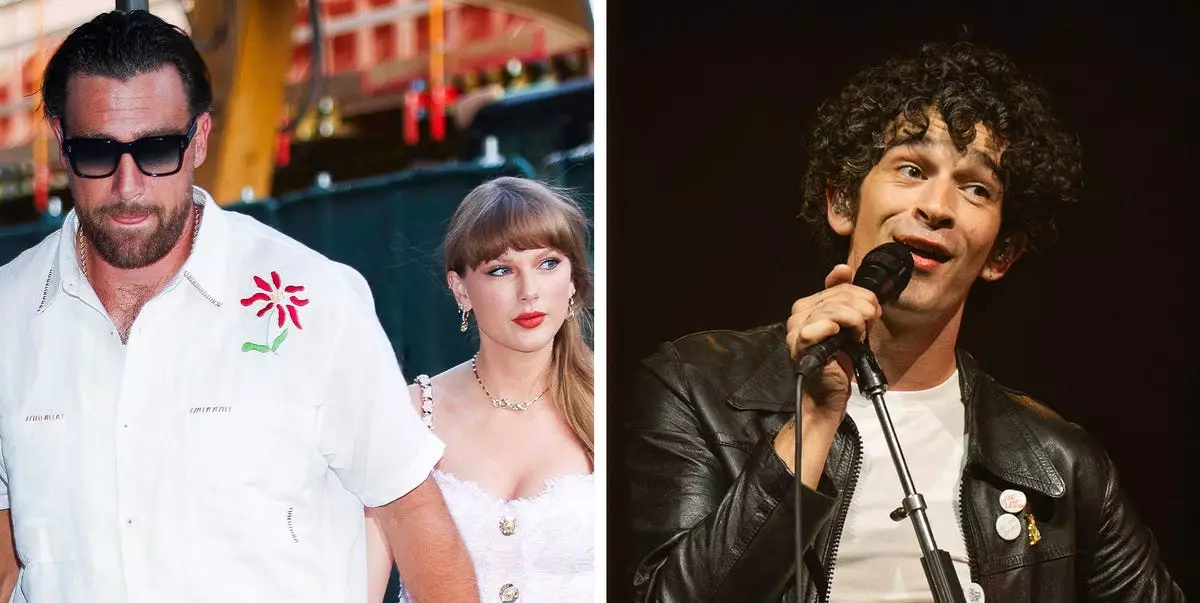In the realm of celebrity and music, words often carry more weight than physical actions. Recently, Matty Healy, frontman of The 1975, showcased this dynamic during his band’s headline performance at Glastonbury 2025. His remarks weren’t just an exercise in self-praise but a direct, sharp-edged commentary aimed at his ex, pop icon Taylor Swift. With a vein of sarcasm, Healy proclaimed himself “probably the best songwriter of my generation,” sarcastically labeling himself a “generational wordsmith” and “poet.” Those familiar with Swift’s discography immediately recognized the jab: her latest album, *The Tortured Poets Department*, is laced with reflections on their turbulent relationship. Healy’s public self-declaration was as much a confrontation as it was artful bravado.
This incident reveals a trend where musicians’ personal lives bleed into their art and public appearances, creating a complex interplay of rivalry, vulnerability, and self-branding. Healy’s Glastonbury speech wasn’t just entertainment; it was a calculated insertion into the ongoing narrative spun by Swift’s emotionally charged album.
Silent Responses: Taylor Swift’s Poise and Strategic Visibility
Swift’s reaction—or more accurately, her deliberate lack of verbal response—speaks volumes about her control over the narrative. Instead of engaging in a public battle of words or social media spats, Swift answered through carefully crafted public appearances. Days after Healy’s pointed performance, she was spotted enjoying a date night in New York City with her boyfriend, Travis Kelce, a prominent NFL athlete. Their matching style and affectionate demeanor captured by paparazzi quickly became more than just evidence of romance; it was a quiet yet powerful statement of moving on and thriving.
The media coverage of this event aptly overshadowed Healy’s provocative Glastonbury moment, flipping the script from confrontation to personal triumph. In choosing poise and positive optics over direct rebuttal, Swift enacted a less flashy but arguably more influential form of communication—living well as her own form of retort. It’s a strategy that amplifies her strength and maturity, underscoring her artistry’s emotional depth beyond mere headlines.
The Intersection of Music, Personal Growth, and Public Persona
This exchange between Healy and Swift highlights a fascinating cultural phenomenon: how artists harness their craft and public personas to process personal drama. Swift’s *The Tortured Poets Department* seems to be a cathartic outlet, with tracks reportedly channeling her feelings about Healy, especially songs like “The Smallest Man Who Ever Lived.” Meanwhile, Healy’s ironic self-praise during his live set reflects a defensive yet performative response—a classic example of the blurred boundaries between life and lyrical content.
Both artists demonstrate their command over the storytelling power of songwriting, turning pain and conflict into commercially and critically resonant art. Their public interplay turns personal strife into a spectacle, but also into creative inspiration. It’s an unapologetic invitation to audiences to witness not just the music, but the human stories fueling it.
Love, Priorities, and the Shift in Taylor Swift’s Life
Beyond the public jabs and artistic output, Swift’s current life chapter shines with a sense of grounded happiness and clear priorities. Her relationship with Travis Kelce, now nearly two years strong, signals stability and a different kind of creative muse. Sources indicate Swift views Kelce as “The One,” even if she’s cautious about rushing into marriage, mindful of its lifelong significance. This contrasts sharply with the emotional turmoil referenced in her new music, suggesting personal evolution.
Interestingly, the couple’s relatively lighter public schedule has allowed Swift to attend Kelce’s NFL games consistently—a departure from relentless tours. This shift appears to rejuvenate her, offering the space to nurture her relationship amidst a demanding professional world. It’s a reminder that even global superstars seek balance and normalcy to sustain their creative and personal well-being.
The saga surrounding Taylor Swift and Matty Healy reminds us that in modern celebrity culture, public discourse between artists rarely exists in spoken words alone. It is woven into albums, performances, public appearances, and the media’s framing of these moments. Swift’s answer through grace and deliberate positivity contrasts Healy’s confrontational performance, illustrating two divergent ways to wield the power of persona and art.
Far from trivial gossip, their interaction exemplifies how creativity, personal growth, and strategic public behavior intertwine, redefining the nature of artistic rivalry. Ultimately, it’s a testament to how powerful, authentic artistic expression can be — not just as a form of self-expression but as a profound, empowering dialogue with the world.

